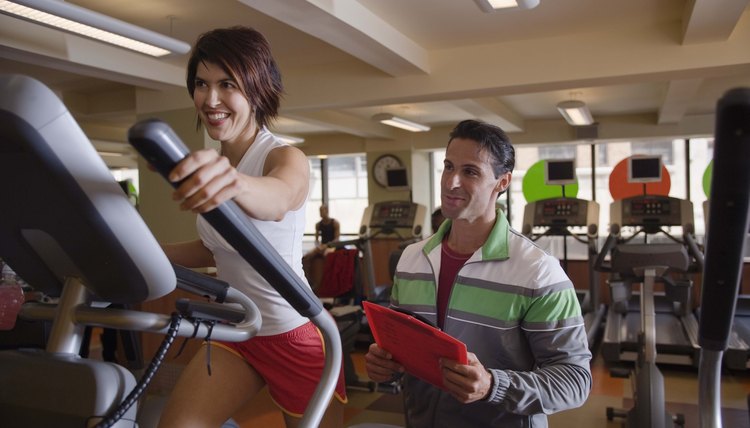What Is the Correct Form & Foot Position for an Elliptical Machine?

If you have knee or arthritis pain that keeps you from jogging, an elliptical trainer can be a pain-free alternative. However, mastering the motion, posture and foot positioning of the elliptical can take some practice. The elliptical trainer -- part jogging, part cross-country skiing and part stair climber -- offers a low-impact cardiovascular workout. Since proper form is vital to exercise success, start slowly with the elliptical machine until you feel confident about your form. Check with your doctor before starting any aerobic exercise program to ensure you’re in good health to begin.
Posture
Good posture on the elliptical machine can prevent shoulder and back soreness and ensure you can increase speed and incline when you desire. When you step onto the elliptical machine, keep your head up, looking forward with your shoulders pulled back -- you should not arch or hunch forward during exercise. Concentrate on keeping your abdominal muscles tightened and activated; this will help you maintain straight posture while working out on the elliptical.
Your Foot Positioning
Elliptical trainers often have wide and long pedals to accommodate differing heights and shoe sizes. This can make finding the right foot placement difficult on an elliptical trainer. The best foot placement is one with which you can comfortably perform the exercise while maintaining. If placing your foot at the very front of the elliptical allows you a better range of motion, keep your foot there. However, if your knee bumps against the moving poles, move your foot backward to put more room between your lower legs and the elliptical poles.
Foot Motion
While the elliptical has elements of jogging, you should not lift your feet off the elliptical with each pedaling motion. Instead, perform a rolling motion that starts at the balls of your feet and ends at your heels as you pedal, recommends the American Council on Exercise. This action helps to prevent too much pressure on the nerves in your feet. If you experience foot numbness or tingling after an elliptical exercise session, you may be placing too much emphasis on the balls of your feet. If you adjust your foot positioning and still feel tingling, your shoes might not fit properly.
Your Hand Positioning
Elliptical trainers typically feature either stationary handles or two pole-like handles that move with each pedaling motion, much as in cross-country skiing. If you do not position yourself properly, you might rely too much on the handles and not enough on your lower body. This can create imbalance. The vast majority of your weight should be concentrated in your lower body, and you should not grip the elliptical’s handles too tightly. Test how much weight you are concentrating in your arms by using the pedals at a moderate pace and momentarily taking your hands away. If you can do this with ease, you are likely correctly balanced. You should not find yourself leaning on the handrails at any time; this promotes incorrect posture.
References
- Shape: How to Use an Elliptical Trainer in Your Cardio Workout Routines
- American College of Sports Medicine: Selecting and Effectively Using an Elliptical Trainer
- MayoClinic.com: Elliptical Machines: Better Than Treadmills?
- American Council on Exercise: Selecting and Effectively Use of Exercise Equipment
Writer Bio
This article was written by the CareerTrend team, copy edited and fact checked through a multi-point auditing system, in efforts to ensure our readers only receive the best information. To submit your questions or ideas, or to simply learn more about CareerTrend, contact us [here](http://careertrend.com/about-us).
